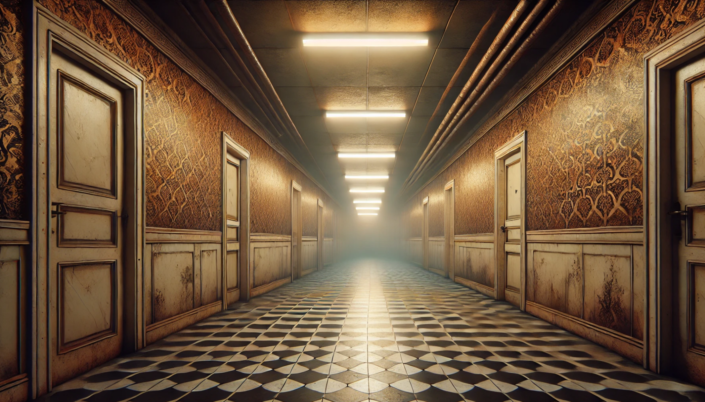Recently, video games have begun to explore these liminal spaces, creating unique experiences that play with our perceptions and emotions. This subgenre, known as “liminal games,” offers a blend of exploration, psychological horror, and deep immersion in environments that seem to come straight out of our dreams (or nightmares).
What is a Liminal Space?
A liminal space refers to a place of transition, a sort of “non-place” that exists between two significant states or moments. These spaces can be physical, such as long corridors, empty train stations, and closed shopping malls, or metaphorical, like phases of change in life. They are characterized by their unsettling and disorienting atmosphere, where the familiar becomes strange and the everyday transforms into something disturbing.
Highlighted Example: “The Backrooms”
One of the most iconic examples is “The Backrooms,” a game inspired by the creepypasta of the same name. This game plunges us into an infinite maze of empty, monotonous rooms, where silence and solitude create an oppressive atmosphere. Players must navigate these endless spaces, confronting their own anxiety and fear of the unknown.
By diving into the concept of liminal spaces, both physical and metaphorical, these games challenge our understanding of reality and push the boundaries of immersive storytelling. As this trend continues to grow, we can expect more innovative and thought-provoking experiences that tap into the eerie beauty of the in-between.
FUN FACT
The term “liminal” comes from the Latin word “limen,” which means “threshold.” Originally used in the context of rites of passage, it has been adopted by psychology and design to describe these intermediary spaces.
KEY POINTS OF LIMINAL GAMES
- Transitional Environments:
Spaces that seem to be between two states, such as hallways, parking lots, closed shopping malls, etc. - Unsettling Atmosphere:
Disorienting and disturbing atmosphere that creates discomfort and anxiety. - Isolation:
Empty or nearly empty places highlighting the player’s solitude and isolation. - Exploration:
Focus on exploring environments, often without clear objectives or with minimalistic goals. - Psychological Horror:
Use of psychological elements to induce fear and tension, rather than sudden jump scares. - Ambiguity:
Lack of clarity in the narrative or purpose, encouraging personal and subjective interpretation of the experience. - Limited Interactivity:
Minimal interactions with the environment or characters, emphasizing atmosphere and exploration. - Monotonous Design:
Use of repetitive and monotonous elements in environment design to amplify the sense of disorientation. - Ambient Sound and Music:
Subtle ambient sounds and minimalistic music reinforcing the unsettling atmosphere. - Retro or Simple Aesthetic:
Often employs retro graphics or simple aesthetics to create a sense of nostalgia and displacement.
SOME LIMINAL GAMES
The Backrooms
This game immerses players in an endless maze of empty, monotonous rooms filled with an eerie silence and isolation.
Anemoiapolis
A surreal exploration game set in a sprawling, empty mall. Players wander through vast, desolate spaces that evoke feelings of disorientation and solitude.
The Stanley Parable
While not strictly a horror game, its narrative-driven exploration of surreal and empty office environments fits the liminal theme, offering a unique psychological experience.
Exit 8
An indie game that masterfully captures the essence of liminal spaces. Set in an eerie, deserted subway station, players navigate through dimly lit corridors and abandoned platforms. The game’s atmosphere is characterized by its silence, broken only by the distant echoes of footsteps and the hum of fluorescent lights. The visual design employs a minimalistic, almost dreamlike quality, enhancing the sense of isolation and unease. As players explore, they encounter cryptic messages and unsettling occurrences, creating a psychological horror experience that leaves a lasting impression.
Platform 8
Takes players on a surreal journey through an endless, deserted train station. The game excels in creating an atmosphere of perpetual transition, with platforms that stretch into infinity and trains that never arrive. The stark, repetitive architecture of the station combined with ambient soundscapes—like the distant rumble of trains and faint announcements—heightens the sense of disorientation. Players must navigate this labyrinthine environment, uncovering hidden stories and confronting their own fears of the unknown and the unending journey. Platform 8 is a haunting exploration of liminal spaces, blending elements of horror and introspection.




